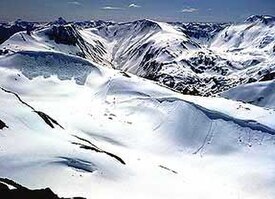
Juneau Icefield

The Juneau Icefield is an ice field located just north of Juneau, Alaska, continuing north through the border with British Columbia,[1] extending through an area of 3,900 square kilometres (1,500 sq mi) in the Coast Range ranging 140 km (87 mi) north to south and 75 km (47 mi) east to west. The icefield is the source of many glaciers, including the Mendenhall Glacier and the Taku Glacier. The icefield is home to over 40 large valley glaciers and 100 smaller ones. The Icefield serves as a tourist attraction with many travellers flown in by helicopter for quick walks on the 240-to-1,400-metre (790 to 4,590 ft) deep ice and the massive, awe-inspiring moist crevasses. The icefield, like many of its glaciers, reached its maximum glaciation point around 1700 and has been in retreat since. Much of the icefield is contained within the Tongass National Forest. Since 1948, the Juneau Icefield Research Program has monitored glaciers of the Juneau Icefield. On the west side of the icefield, from 1946-2009, the terminus of the Mendenhall Glacier has retreated over 700 metres (0.43 mi).


Eight kilometers to the north, the Herbert Glacier has retreated 540 m (0.34 mi), while Eagle Glacier retreated 700 m (0.43 mi), Gilkey Glacier 3,500 m (2.2 mi) and Llewellyn Glacier 2,800 m (1.7 mi). On the south side of the icefield, the Norris Glacier retreated 1,740 m (1.08 mi), the East Twin Glacier 1,100 m (0.68 mi), the West Twin Glacier 570 m (0.35 mi) with only the Taku Glacier advancing. Surveys reveal the Taku as one of the deepest glaciers of the sub-temperate icefields surveyed at nearly 1,370 metres (4,490 ft) thick.[2] This glacier was advancing in 1890 when viewed by John Muir and had a large calving front. By 1963, the glacier had advanced 5.6 km (3.5 mi). In 1948, the Taku Fjord had been completely filled in with glacial sediment and the glacier no longer calved. From 1948–1986, the glacier had a positive glacier mass balance driving the advance. From 1987–2009, the glacier has had a slightly negative mass balance, not enough to end the advance, but if it continues will soon slow it.

Notable peaks on the Juneau Icefield are Devils Paw, Nelles Peak, Emperor Peak, The Snow Towers, Taku Towers, Camp 15 Peak, and the Mendenhall Towers.

See also
- List of glaciers and icefields
- Retreat of glaciers since 1850
- Ha-Iltzuk Icefield
- Homathko Icefield
- Lillooet Icecap
Gallery
-
Juneau Icefield showing Devils Paw and Nelles Peak
-
Spirit Range, over the Juneau Icefield
-
Several prominent peaks in the icefield
-
Juneau Icefield looking Northwest
References
- ^ "Juneau Icefield Research Program".
- ^ Nolan, Matt; Motkya, Roman J.; Echelmeyer, Keith; Trabant, Dennis C. (1995). "Ice-thickness measurements of Taku Glacier, Alaska, U.S.A., and their relevance to its recent behavior". Journal of Glaciology. 41 (139): 541–553. doi:10.3189/S0022143000034870. ISSN 0022-1430.
External links
- Terminus Behavior of Juneau Icefield Glaciers 1948-2005
- Forest Service overview
- Juneau Icefield Research Program
- Canadian Mountain Encyclopedia: Juneau Icefield entry
- crevassezone.org
- Pictures from the Juneau Icefield Research Program
- Pulitzer Center Crisis Reporting Juneau Icefield Research (multimedia)
- A description of the flora and fauna in the Icefield
58°36′N 134°30′W / 58.600°N 134.500°W

See what we do next...
OR
By submitting your email or phone number, you're giving mschf permission to send you email and/or recurring marketing texts. Data rates may apply. Text stop to cancel, help for help.
Success: You're subscribed now !




